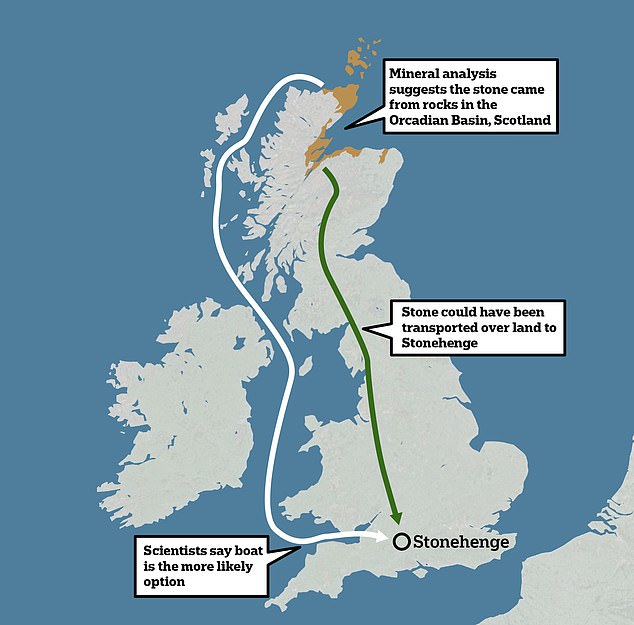Mysterious new Stonehenge discovery deepens puzzle over the origins of the monument
- Scientists studied the mineral grains within fragments of the Altar Stone
- Their analysis matched it with rocks from northeast Scotland
They're the circle of stones that have left historians scratching their heads for centuries.
Now, experts have made a 'stunning' discovery about one of Stonehenge's most famous rocks.
It has been known for a while that most of the monument's world-renowned 'bluestones' were sourced from the Preseli Hills in Wales, around 240km (150 miles) from the site in Wiltshire.
But new analysis has revealed the Altar Stone, the largest bluestone at the centre of Stonehenge, actually came from northern Scotland – up to 1,000km (621 miles) away.
Experts have no idea why the six-tonne, 5m-long stone was selected, nor how it was transported such a long distance around 5,000 years ago.

They're the circle of stones that have left historians scratching their heads for centuries. Now, experts have made a 'stunning' discovery about one of Stonehenge's most famous rocks

New analysis has revealed the Altar Stone, the largest bluestone at the centre of Stonehenge, actually came from northern Scotland – up to 1,000km (621 miles) away
The discovery was made when a team, led by researchers from Curtin University in Perth, analysed the age and chemistry of minerals from fragments of the Altar Stone.
They found a remarkable similarity with the Old Red Sandstone of the Orcadian Basin in northeast Scotland.
The team said they can conclude with 95 per cent accuracy that the stone came from this area – which encompasses parts of Inverness, Thurso, Orkney and parts of Shetland.
The 'fingerprint' of the mineral grains within the sandstone are completely different to Welsh-sourced stones.
'The findings are truly remarkable – they overturns what had been thought for the past century,' co-author Professor Richard Bevins, from Aberystwyth University said.
'We have succeeded in working out, if you like, the age and chemical fingerprints of perhaps one of the most famous stones in the world-renowned ancient monument.
'It's thrilling to know that our chemical analysis and dating work has finally unlocked this great mystery.

The discovery was made when a team, led by researchers from Curtin University in Perth, analysed the age and chemistry of minerals from fragments of the Altar Stone (circled)

The team said they can conclude with 95 per cent accuracy that the stone (pictured here, underneath two bigger Sarsen stones) came from the area that encompasses parts of Inverness, Thurso, Orkney and parts of Shetland
'We can now say that this iconic rock is Scottish and not Welsh.'
While the research, published in the journal Nature, does not provide direct evidence about how the Altar Stone got to its location in Salisbury Plain, the revelation it travelled so far has raised questions about its journey given the limits of human technology during Neolithic times.
Professor Nick Pearce, also from Aberystwyth University said: 'This stone has travelled an awful long way – at least 700 km - and this is the longest recorded journey for any stone used in a monument at that period.
'The distance travelled is astonishing for the time. While the purpose of our new, empirical research was not to answer the question of how it got there, there are obvious physical barriers to transporting by land, but a daunting journey if going by sea.
'There's no doubt that this Scottish source shows a high level of societal organisation in the British Isles during the period.'
Construction at Stonehenge began 5,000 years ago, with changes and additions over the next two millennia.

During analysis in the lab, the researchers found a remarkable similarity with the Old Red Sandstone of the Orcadian Basin in northeast Scotland
The researchers said the Altar Stone was most likely extracted from the Orcadian Basin using stone wedges and hammerstones to exploit natural joints within the rock.
Although it is unclear when the Altar Stone arrived at Stonehenge, it may have been placed within the world-renowned central horseshoe of stones during the second construction phase at around 2620 – 2480 BC.
Lead author Anthony Clarke from Curtin University said: 'Given its Scottish origins, the findings raise fascinating questions, considering the technological constraints of the Neolithic era, as to how such a massive stone was transported over vast distances around 2600 BC.'
Previous studies indicate the larger upstanding 'sarsen' stones, which make up the outer circle of Stonehenge, were sourced from the edge of the Marlborough Downs, around 15 miles north of the site.
The research also involved scientists from University College London (UCL) and the University of Adelaide.
The team said their next step will be further pinpointing the origin of the stone within the Orcadian Basin.





















































































































































































































































